LEDs are DC devices, operating from a few volts of direct current. Where power is supplied by a DC battery like mobile phone, or torch, you can easily run LEDs.
But running LEDs by AC requires a driver. Appropriate LED driver is required for the LED to last longer.
While LED itself costs less, say Re.1/pcs the driver circuit is often costlier than the LED itself.
The good news is that you can run LEDs without any complicated driver circuit. A good maths will help you design your driver circuit such that it ensures your LEDs are safe.
Today I'm going to build one LED array that runs off mains i.e. 230V AC. Here, multiple LEDs are connected in series so that the voltage drop across the array equals the supply voltage.
Certainly it is not the right SAFE way to drive a LED array, but it's the simplest out there. Since there are no converters used, the efficiency of this circuit is much higher than other drivers.
Construction of the 230V LED driver
First I convert the 230V AC to DC by using a bridge rectifier and a capacitor. 230V AC becomes 230x√2=325V DC. A typical white LED runs on ideal 3.6V, but can run from 3V to 4V(max).
Feeding 325V DC into a series of such LEDs will require 90 LEDs (3.6V each). In my prototype I'm using 12x8=96 LEDs in array, so each LED will get 3.38Volts which is a bit less and will cause my LED strip to be less bright. But in other hands, I'm protected from little over-voltage spikes that may happen in mains line.
This is my schematics. I have used a bridge rectifier built by 4x IN4007 diodes, and a 4.7uF/450V capacitor for smoothing the DC wave. Use of the capacitor removes flickers from the output light.
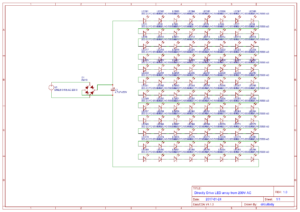 Now it's turn to make the physical circuit. I've used a 4"x6" PVC switch box as an enclosure. I used a thick needle to make the holes and arrange the LEDs in 8 rows and 12 columns.
Now it's turn to make the physical circuit. I've used a 4"x6" PVC switch box as an enclosure. I used a thick needle to make the holes and arrange the LEDs in 8 rows and 12 columns.
After connecting LEDs in series I test the LEDs by adding the bridge rectifier/capacitor circuit. All LEDs glow up in even brightness and none burned.
The advantage of connecting LED in series is that only one LED will burn in case of burning. From the top, you will be able to see a brown/black dot in middle of the LED (yellowish area). This way replacing that particular LED is easy.
Now I place eveything inside the 4"x6" PVC board and I add an AC wire. Right now it's been running for 2+ hours and no heating or burning. It's successful.
If you build one like this or get any inspiration to make yours by different way, let me know by dropping a comment below.
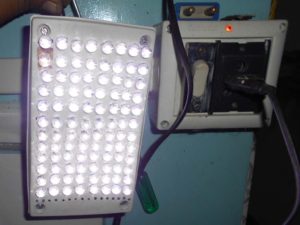
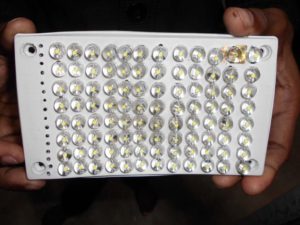
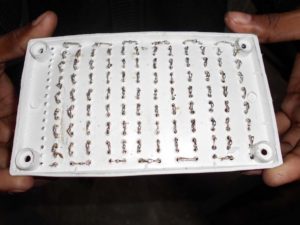
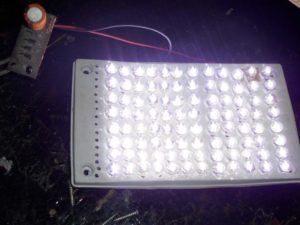
Awesome !
Commendable! You have kept it simple and straightforward, doing away with the series dropping capacitor normally used in AC operated LED circuits using lesser number of LED's. The concept can be used to assemble an LED based tube light costing around Rs 100.
Brilliant! How about limiting current with resistors? My understanding is that the LED panel will consume whatever current your AC mains can throw at it, hence making it less efficient?
I gather from your post that the LEDs have Vf of around 3.38V. What are they rated for Imax?
I want to experiment this circuit with some higher power LED arrays, but worried that it would consume too much current and trip my circuit breaker. If you can help clarify the current limiting aspect, that would be awesome.
Thanks,
Al
These LEDs are sold as 0.25 watt LED, and forward current should be around 80mA.
There's no need of a current limiting resistor, as current is limited by the Vf of LEDs.
Generally LEDs have a Vf of around 3.6V at it's peak operating current, but here each LED is getting around 3.38V, so current wont rise much.
LEDs are safe until there's a reasonably high voltage surge in the power supply, this could be eliminated by using a PTC in series and 330V zener diode in parallel to LED string.
Arnab is correct, there is no need for a limiting resistor.
but a PTC won't be that effective since the response time for a PTC is slow, and a sudden surge in the voltage can destroy a few LED's before the PTC kicks in. Again, I think a 330 volt zener is going to act more like a fusible resistor, since without a current limiting resistor it will definitely burn out if triggered.
Having said that, I personally don't think that a small surge is going to have any effect on the LED's since they are already working well within their limits.
Thanks ! Great feedback, and I too think PTC is useless here.
But a 1 watt Zener can handle surge of few hundred milliseconds easily, from whatever I've observed while playing around in collage lab.
Thanks for your suggestion. I will try it.
Is your circuit still working? Hasn't blown up by spike on mains? I would like to know how much current and how many watts it consumes. If this actually works, it is easily the simplest LED driver ever made. Would it still be safe running on 240 volts?
It should work without any problem, I presume.
Dear Sir ARNAB,
Very kindly tell me what is the value of the RESISTOR which you have attached with the 4.7uf/450V Elect.capacitor! Thanks for your reply.
Best Regards
Johnson
It's a bleed resistor for discharging the cap when voltage is removed. Make it 220k or so.
I would caution that this circuit can cause shocks if touched anywhere.
Please remove previous comment. It is in error (apart from circuit can cause shocks)
Hello,
Your page on https://www.circuitsdiy.com/directly-drive-led-array-230v-ac/
Directly Drive LED array from 230V AC
What I don't understand is why there never mentioned is about which LEDs are used, is here as well.
What is D1 and V1?
The LEDs are cheapest available 250mW, 8mm LED, driving voltage is around 3.5V to 4V.
Which one is D1 please ?
The LED is something like: Straw Hat White 5 mm Ultra Bright Pure White LED Diode 15000-18000MCD
Sorry found, V1 is the current entrance.
But at D1 State 2W10, is this Bridge Rectifier Diode, Single, 1000 V, 2 A, Through Hole, 1.1 V, 4 Pins?
can the array be built without the bridge rectifier diodes? Say as an a liner strip array of 96 sets of ( 2 LED s back to back). I have seen a few such concepts on the WEB. This way each set would function as half wave rectifire. Please comment. Thanks